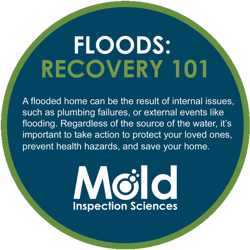Flood Recovery – The Safe Way to Deal with Flooding

It's Flooding Down in Texas
Our sister company, Mold Inspection Sciences Texas, has been a part of the recovery efforts from the devastating floods that have impacted Houston and the Southern Texas region. Together we’ve been working to spread the word on flood recovery. While you might not live in a location prone to flooding, it is essential to know what to do if flooding does occur.
A flooded home can be the result of internal issues, such as plumbing failures or external events like weather-related flooding. Regardless of the source of the water, it’s crucial to take action to protect your loved ones, prevent health hazards, and save your home from further damage.
What to Do If My House Floods?
When it comes to water damage, even minor issues should be addressed. Mold, which grows where there is moisture, can have a significant impact on indoor air quality and can cause serious health problems. Visible mold growth can be seen in as little as 24 hours. It’s critical to be proactive and work on drying out your home within the first 48 hours after water damage first occurs.
The key to controlling a mold problem is to control the moisture.
Internal Flooding
Immediately following a flooding event, take these actions first.
- Stop the Flow of Water - If the flooding is internal, then you want to stop it as soon as possible. The quickest way to do this is to locate and turn off the main water valve.
- Turn Off the Electricity - Once the water flow has been stopped, evaluate the situation, and if there is standing water at the level that may reach any electrical systems or appliances, turn off the electricity in your home. If you can’t reach the circuit breaker without going through water, call for help. But, do not walk through the water as it may conduct electricity.
- Evacuate When Necessary - If the problem is more severe like a pipe burst you are unable to stop, or a sewage leak, leave the home for a safe spot. Make sure your loved ones are accounted for and unharmed. Once everyone is relocated, you can begin the recovery process.
External Flooding
When it comes to flooding as a result of weather or natural disasters, it’s important to be alert to your surroundings and monitor local weather.
If you’ve had the time to put a plan together, then you are ahead of the game, but if you haven’t, here are a few things to consider for flood preparation.
- Assemble Disaster Supplies – Think non-perishable food, drinking water, medications, and first aid supplies. Clean clothing, toiletries battery-powered radio, flashlights, and any relevant documents you might need.
- Be Prepared to Evacuate – Identify safe places to go, alternative travel routes clear of flooding, and ensure your gas tank is full whenever possible.
- Proactively Protect Your Property – Move valuables, furniture, and hazardous materials to higher levels. Disconnect electrical appliances or systems in your home. Secure any outdoor furniture and possessions and seal lower level vents to help prevent flooding.
Download our Free Flood Recovery Check List

This free download will help you confidently move forward with a flood recovery plan of action to ensure that you proceed the safe way and the right way.
The Cleanup
Before re-entering your property, make sure it’s safe with no structural, electrical, or other hazards. Also, be sure to contact your insurance company and take pictures of the property and your belongings. As we noted earlier, use caution if the building materials or furniture has been affected by the flooding. In particular, if any material has been wet for more than 24-hours, it is important to treat it as if mold is starting to grow. When in doubt, we always recommend contacting a certified mold inspection organization and completing a mold inspection along with appropriate testing.
If the source of the water cannot be stopped, you’ll need to call in the professionals before taking any other steps.
A common mistake property owners make is to begin the process of removing wet material only to find visible mold growth. Rather than stopping at that point, they continue to remove the material. While this may seem a logical action, it can, in fact, make the situation worse. Once mold growth is exposed, the mold spores are easily dispersed. If those spores end up on other wet material, the scope of the mold growth will increase – as will the scope of any required remediation to remove the mold.
As a property owner, the focus should be on drying the material as quickly as possible with as little disturbance as possible. If mold growth is observed or suspected, the best course of action is to have a mold inspection along with appropriate samples completed. This way, the scale of mold contamination, if any, is known.
In addition, people with weak immune systems or breathing problems and children should stay away from the suspected area and should not take part in any cleanup work.
With all that in mind, here are the steps to take if your property is affected by flooding:
- Remove Standing Water
The first thing you want to do is remove any standing water that is left in your property as soon as possible. In addition to being a catalyst to mold growth, bacteria and microorganisms thrive in standing water. If the water is left standing, they can multiply and disperse into the air quickly, becoming a health hazard. Floodwaters may have been mixed with dirt, sewage, or other substances that may have brought harmful contaminants into your home. In some cases, a pump can be used to remove the water from the house. You should follow up with a wet vacuum to remove water from the floors, carpets, rugs, and other hard surfaces.
- Ventilate
Good airflow will help dry out a space once the standing water is removed. Opening windows and doors can help naturally dry out the home and some of your big personal items like furniture. Fans are also recommended to help encourage airflow through the property. If you observe or suspect mold is already growing, do not use fans as they will aid in the spreading of mold spores.
- Dehumidify
If your home is damp after a disaster, using a dehumidifier can help improve the air quality and prevent mold from developing. If you do use a dehumidifier, be sure to close all windows and doors of the targeted area so the device will work properly and regulate the air. The decision to ventilate vs. dehumidify will depend on your location, the current weather, and your access to fans and dehumidifiers.
- Sort Your Affected Belongings
Dispose of items that can’t be cleaned or dried. Other wet items that you intend to save should be removed from the home. Placing soaked items outside of the house can help them dry out better and is less likely to support mold growth. Be sure to clean your salvaged items thoroughly using water and your choice of detergent and dry the items right away. Seek professional drying or cleaning if necessary.
- Dry Out the Walls
Mold can grow hidden inside the walls, so it’s essential to make sure that air circulation can reach these areas too. Cutting small holes along the base of the affected wall can help dry out the layers of the wall itself. If you observe mold growth when making these ventilation holes, do not make any new holes and limit the use of fans for drying as this can spread the mold spores over a wider area.
- Hire the Help You Need
Drying out, cleaning, repairing, and restoring the damaged parts of your home might be too dangerous or difficult – and certainly, if you observe or suspect mold growth, you should take a step back. Luckily there are experienced qualified professionals to help. If you can, hire a mold inspector. Even without water damage, mold can grow unseen and unknown in a home. It’s important to note that your inspection company should be standalone. Mold Inspection Sciences, for example, does not do remediation or removal of mold.
There’s often a conflict of interest, and we recommend checking to see if your state regulates remediation. This means the mold inspector and mold remediator cannot be from the same company. There are many reasons why you should not have the remediation done by the same inspection company and vice versa. The bottom line is they are two different processes that should be kept separate to protect the best interest of the property owner. And remember, no matter what’s going on with your property post-flood, it’s crucial for you to know if the potential for hidden mold growth is there. If it is, you should fix the moisture problem and clean and remove any mold growth to ensure your property remains in a healthy state.
Be Proactive
After a disaster like flooding strikes, be prepared to act. As mentioned above, mold can begin growing after the first 24 hours of water exposure. It’s important to get rid of standing water and moisture as soon as possible. Confronting the damage head-on can help you prevent a mold issue keeping your property, yourself, and your loved ones healthy and safe.

